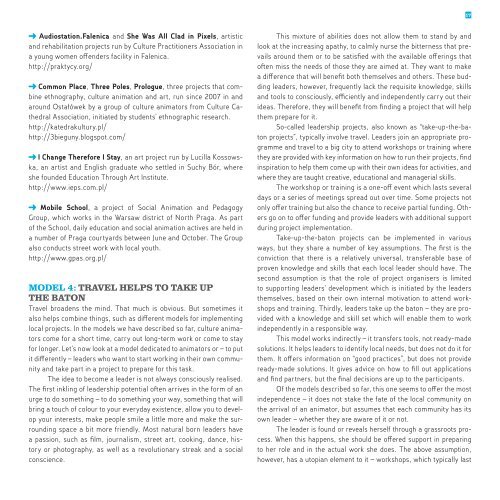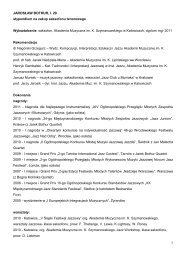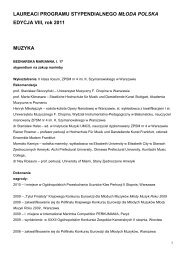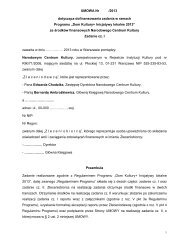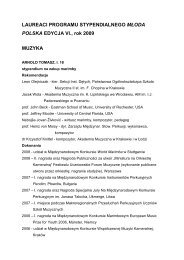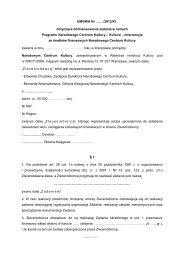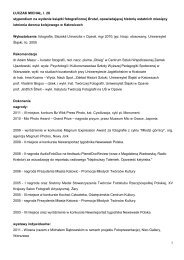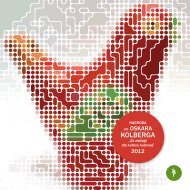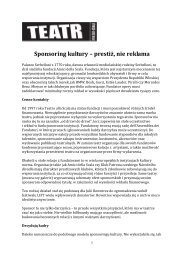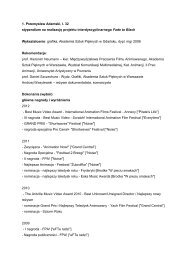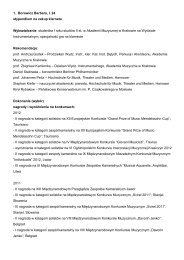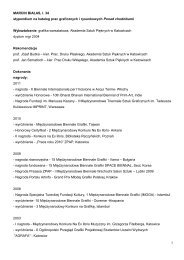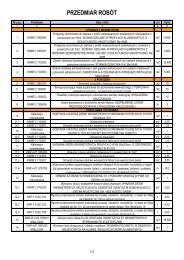Untitled - Narodowe Centrum Kultury
Untitled - Narodowe Centrum Kultury
Untitled - Narodowe Centrum Kultury
You also want an ePaper? Increase the reach of your titles
YUMPU automatically turns print PDFs into web optimized ePapers that Google loves.
tytuł artykułu 17<br />
Audiostation.Falenica and She Was All Clad in Pixels, artistic<br />
and rehabilitation projects run by Culture Practitioners Association in<br />
a young women offenders facility in Falenica.<br />
http://praktycy.org/<br />
Common Place, Three Poles, Prologue, three projects that combine<br />
ethnography, culture animation and art, run since 2007 in and<br />
around Ostałówek by a group of culture animators from Culture Cathedral<br />
Association, initiated by students’ ethnographic research.<br />
http://katedrakultury.pl/<br />
http://3bieguny.blogspot.com/<br />
I Change Therefore I Stay, an art project run by Lucilla Kossowska,<br />
an artist and English graduate who settled in Suchy Bór, where<br />
she founded Education Through Art Institute.<br />
http://www.ieps.com.pl/<br />
Mobile School, a project of Social Animation and Pedagogy<br />
Group, which works in the Warsaw district of North Praga. As part<br />
of the School, daily education and social animation actives are held in<br />
a number of Praga courtyards between June and October. The Group<br />
also conducts street work with local youth.<br />
http://www.gpas.org.pl/<br />
Model 4: Travel helps to take up<br />
the baton<br />
Travel broadens the mind. That much is obvious. But sometimes it<br />
also helps combine things, such as different models for implementing<br />
local projects. In the models we have described so far, culture animators<br />
come for a short time, carry out long-term work or come to stay<br />
for longer. Let’s now look at a model dedicated to animators or – to put<br />
it differently – leaders who want to start working in their own community<br />
and take part in a project to prepare for this task.<br />
The idea to become a leader is not always consciously realised.<br />
The first inkling of leadership potential often arrives in the form of an<br />
urge to do something – to do something your way, something that will<br />
bring a touch of colour to your everyday existence, allow you to develop<br />
your interests, make people smile a little more and make the surrounding<br />
space a bit more friendly. Most natural born leaders have<br />
a passion, such as film, journalism, street art, cooking, dance, history<br />
or photography, as well as a revolutionary streak and a social<br />
conscience.<br />
This mixture of abilities does not allow them to stand by and<br />
look at the increasing apathy, to calmly nurse the bitterness that prevails<br />
around them or to be satisfied with the available offerings that<br />
often miss the needs of those they are aimed at. They want to make<br />
a difference that will benefit both themselves and others. These budding<br />
leaders, however, frequently lack the requisite knowledge, skills<br />
and tools to consciously, efficiently and independently carry out their<br />
ideas. Therefore, they will benefit from finding a project that will help<br />
them prepare for it.<br />
So-called leadership projects, also known as “take-up-the-baton<br />
projects”, typically involve travel. Leaders join an appropriate programme<br />
and travel to a big city to attend workshops or training where<br />
they are provided with key information on how to run their projects, find<br />
inspiration to help them come up with their own ideas for activities, and<br />
where they are taught creative, educational and managerial skills.<br />
The workshop or training is a one-off event which lasts several<br />
days or a series of meetings spread out over time. Some projects not<br />
only offer training but also the chance to receive partial funding. Others<br />
go on to offer funding and provide leaders with additional support<br />
during project implementation.<br />
Take-up-the-baton projects can be implemented in various<br />
ways, but they share a number of key assumptions. The first is the<br />
conviction that there is a relatively universal, transferable base of<br />
proven knowledge and skills that each local leader should have. The<br />
second assumption is that the role of project organisers is limited<br />
to supporting leaders’ development which is initiated by the leaders<br />
themselves, based on their own internal motivation to attend workshops<br />
and training. Thirdly, leaders take up the baton – they are provided<br />
with a knowledge and skill set which will enable them to work<br />
independently in a responsible way.<br />
This model works indirectly – it transfers tools, not ready-made<br />
solutions. It helps leaders to identify local needs, but does not do it for<br />
them. It offers information on “good practices”, but does not provide<br />
ready-made solutions. It gives advice on how to fill out applications<br />
and find partners, but the final decisions are up to the participants.<br />
Of the models described so far, this one seems to offer the most<br />
independence – it does not stake the fate of the local community on<br />
the arrival of an animator, but assumes that each community has its<br />
own leader – whether they are aware of it or not.<br />
The leader is found or reveals herself through a grassroots process.<br />
When this happens, she should be offered support in preparing<br />
to her role and in the actual work she does. The above assumption,<br />
however, has a utopian element to it – workshops, which typically last


